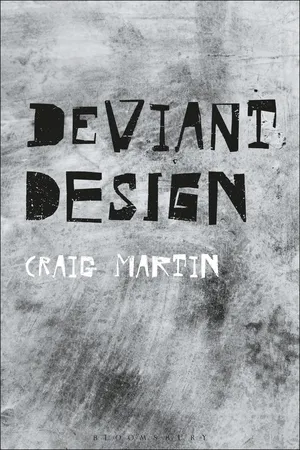
- 224 pages
- English
- ePUB (mobile friendly)
- Available on iOS & Android
About this book
Craig Martin addresses the transgressive or deviant aspects of design: design that straddles the divide between the licit and illicit, the legal and illegal, in a variety of ways. Martin argues that design is not necessarily for the social good, but that it is immersed in the social realm in all its contradictions and confusions. Through a series of case studies he explores a wide range of social practices that employ illicit forms of design thinking, including: early computer hacking and present-day hacker culture in which everyday objects are repurposed and deliberately misused; the cultures of reproduction, counterfeit and pirated versions of classic and luxury designs; and the use of material practices by smugglers to conceal drugs within consumer goods and luggage. Deviant Design contends that these amateur and illicit practices challenge the normative idea of the professional designer or maker. Rather than being reliant on the services of institutionalized design professionals, the adhocist practitioner displays forms of innovative design knowledge in understanding how artefacts have an inherent potential to be misused or repurposed.
Frequently asked questions
- Essential is ideal for learners and professionals who enjoy exploring a wide range of subjects. Access the Essential Library with 800,000+ trusted titles and best-sellers across business, personal growth, and the humanities. Includes unlimited reading time and Standard Read Aloud voice.
- Complete: Perfect for advanced learners and researchers needing full, unrestricted access. Unlock 1.4M+ books across hundreds of subjects, including academic and specialized titles. The Complete Plan also includes advanced features like Premium Read Aloud and Research Assistant.
Please note we cannot support devices running on iOS 13 and Android 7 or earlier. Learn more about using the app.
Information
Table of contents
- Cover
- Halftitle Page
- Title Page
- Contents
- Figures
- Acknowledgements
- Introduction: Heterodox design
- 1 Expanding design
- 2 ‘Social design’ is not social enough
- 3 Valuing the deviant and the illicit
- 4 Misusing things
- 5 Illicit design
- 6 Counterfeit design
- Conclusion: The ethics of change?
- Notes
- References
- Index
- Imprint